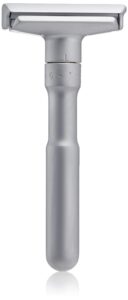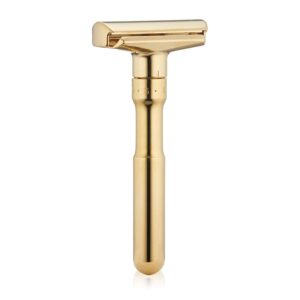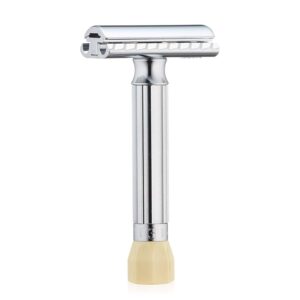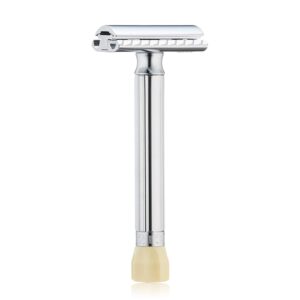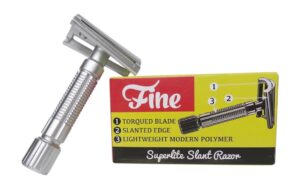When debating the best adjustable safety razor you inevitably end up with the question of Merkur Progress vs Futur. Which is better for you?
Both are exceptional razors from one of the top safety razor brands in the world, and yet they seem totally different. So how do they really differ?
Our Top Pick: Merkur Futur
- 6 Adjustable Aggression settings
- Long Handle
- Futuristic design
- Smooth handle is slippery
- Unusual head mechanism
Runner Up: Merkur Progress
- Adjustable
- efficient
- lightweight
- Poor grip
- check head alignment
- Unsightly knob
How Adjustable Safety Razors Work
The aggression of a safety razor is largely defined by the angle of the blade and the blade gap. The blade gap is the amount of razor blade that is exposed above the comb-guard of the base plate.
Adjustable safety razors work by bending the razor blade with a screw mechanism so that less blade is exposed and the angle becomes sharper. That means the blade bends closer to the safety guard, thus reducing the blade gap.
Whatever your preference, another way to change the aggresiveness of your razor is your choice of safety razor blades. Feather are renowned for producing the sharpest razor blades for this purpose.
There are other benefits to adjustable safey razors besides the closeness of the shave. If you don’t shave very regularly then a wider blade gap can prevent your razor from getting clogged as easily.
Merkur Progress vs Futur Shaving Performance
It is quite easy to conclude that both adjustable razors offer an excellent shave. We are afterall comparing two Merkur razors and the simple fact is you won’t be disappointed with either of them. An obvious advantage with adjustable razors is you can adjust them to suit you – so each has a fair margin of error in terms of aggression.
Overall the Merkur Futur has a very marginal lead in terms of the cleanest smoothest shave. You can hear the bristles catching the blade with a kind of ringing sound.
It is because of this and a variety of other factors that the Merkur Futur features as our top choice in our list of the best safety razor to buy today.
Merkur Progress vs Futur Design
In terms of overall design we have to say the Merkur Futur wins by an incredible stretch – and we don’t just mean because of its flashy looks.
The Merkur Progress uses a big plastic knob at the bottom of the handle for adjusting the blade gap. It’s very unsightly. The Merkur Futur on the other hand has the adjustment dial integrated within the handle – you turn the handle itself to adjust the blade gap.
That’s not all – the Merkur Progress has a number of minor pitfalls in its design. The head assembles with the top plate carrying the screw. You place the screw in the handle and twist the adjustor knob to tighten it.
On one end of the base plate there is a triangle while on one end of the top plate is a little notch mark. It is essential that these line up when the razor is assembled.
That said, while the Merkur Futur clearly leads on the design front it is by no means perfect. The head pops off with a clip mechanism when changing the blade. This is secure and reliable but some people don’t like it and it does require a little extra care.
Merkur Futur vs Progress: Size and Weight
Some people find the Merkur Futur a little bulky. But most love the extra handle length it provides. On the other hand the Merkur Progress has a very short handle.
The Merkur 43C is a very successful short-handled razor but features a lot of knurling – the texture that gives it lots of grip.
The Merkur Progress on the other hand has a much smoother fluting effect that is slippery when wet. On a short handle this can be difficult and you may need to adjust your grip to suit it. However, the Merkur Progress does have a long handle option the Merkur 51.
The Merkur Futur also lacks any texture on the handle but has an indentation that gives it extra grip as well as a generous long handle.
The trade off is the Merkur Progress weighs only 93 grams compared to the Futur’s 128 grams. That’s simply a matter of personal preference.
One setback for the Murkur Futur is the size of the head. It actually covers the ends of the blade and so is much wider than most safety razor heads which can seem quite bulky.
Most of the time this isn’t really an issue, and the shave feels very close with a satisfying sound. However, for small areas like under the nose this can be a little cumbersome.
Cost
In terms of cost the two adjustable safety razors are roughly comparable and both are at the premium end of Merkur razors. The Futur is just slightly more expensive than the standard Progress but slightly cheaper than the long handle Progress.
Other Adjustable Safety Razors
While we certainly like to evangelize Merkur, contrary to popular belief they did not invent the adjustable safety razor.
The first adjustable safety razor actually came from the godfather of all safety razors – before it pivoted to fuel the modern obsession with multi-blade plastic cartridges – Gillette.
The Gillette 195 Adjustable Safety Razor, known as the “Fatboy”, was made for three and a half years between 1958 and 1962 and also featured a butterfly safety razor head. The original retail list price was $1.95 and this is where the 195 comes from in its official name.
Today there are a number of top adjustable safety razors besides the Merkur Futur and Progress. The Parker Variant is a recent addition from 2016 while other brand new entrants include Vikings Blade and Rockwell.
Learn about them and more with our top picks of the best adjustable safety razors.

